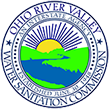Hydropower facilities can have two types of impacts on a river and its resident aquatic life. First, the turbines can cause mortality to fish which pass through the facility. Second, the diversion of river flow through a hydropower facility can prevent the rapid introduction of oxygen which would occur if the water passed over the dam. During low flow periods, aeration at dams is the major source of oxygen to the Ohio River.
The Commission adopted a policy on hydropower development at Ohio River dams which calls for each developer to conduct studies to determine the level of aeration provided by the dam prior to hydropower construction, to provide capabilities in facility design and operation to replace the aeration capacity when needed to maintain stream dissolved oxygen (DO) levels, and continuous monitoring of DO levels above and below the facility, with results made available to ORSANCO through telemetry in order to allow real time response to adverse conditions. The Federal Energy Regulatory Commission (FERC) has cooperated by placing conditions in new licenses for Ohio River hydropower projects that call for ORSANCO review of facility monitoring plans.
Dissolved oxygen monitors at the existing hydropower facilities are interrogated from Commission headquarters on a daily basis from May through October. If critical conditions begin to develop, operators, as well as state and federal agencies, are alerted. If DO levels approach minimum allowable levels, hydropower operators and the Corps are requested to take action to maximize aeration at the dams and thereby increase DO levels.
As new hydropower facilities are developed, it is important that procedures to respond to impending water quality problems keep pace. The facilities are located at navigation dams operated by the Corps of Engineers and the Corps plays a key role in assuring adequate controls on their impact. Commission staff works with the Corps to refine procedures now in place for response to low DO levels.

